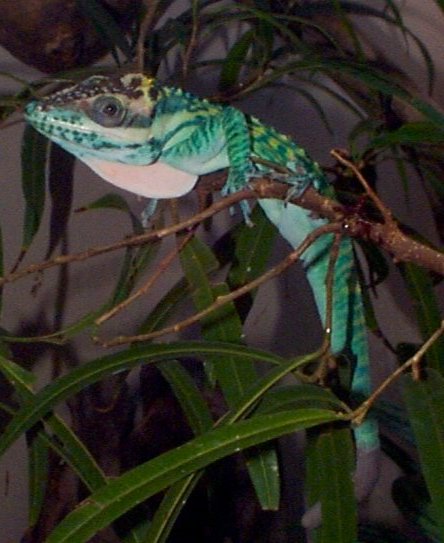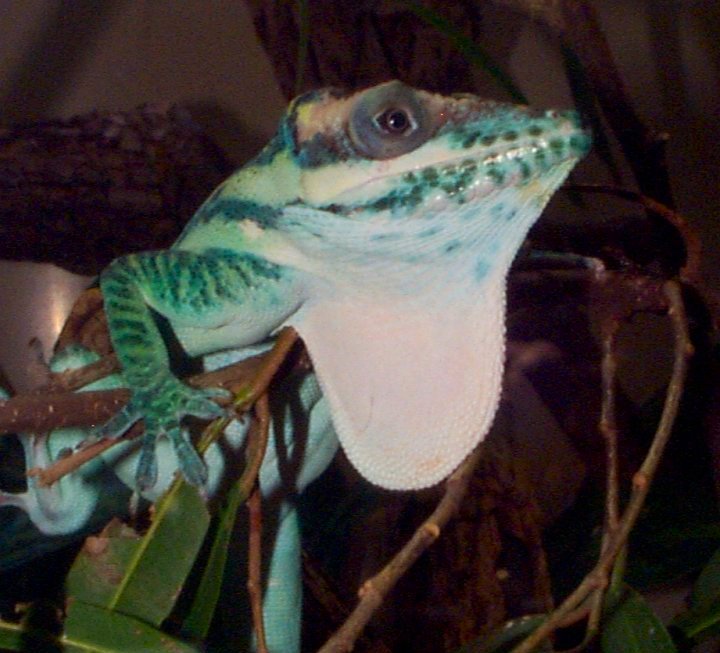 |
Scientific Name: Anolis
equestris |
| Geographical Range: Native
to Cuba, they are commonly found in southeastern Florida, Jamaica, and
the Carribean. |
| Habitat: Knight
Anoles are commonly found under shady areas of trees. They prefer a warm
and humid climate. |
| Diet in the Wild: They eat grubs, spiders,
medium to large sized insects, tree frogs, and moths. In captivity
they can be fed crickets, earthworms, smaller lizards, and pink mice. |
| Conservation Status: Not protected. |
| Location in the Zoo: Herpetarium |
|
|
| Physical Description: The Knight
anole is the largest Anolis species in the world. They grow
in length from 13-19 3/8 inches. The head is large and bony, and
their eyes can move independently. They have strong jaws and sharp teeth.
The tail is often longer than the entire body and has a jagged upper edge.
They have special adhesive lamella on their five clawed toes that allow
them to stick to surfaces making it easier for them to run. This adhesive
pad is located on the central part of each toe. Their body is covered with
small granular scales with two white or yellowish stripes below each eye
and over each shoulder. They are a bright green color, which can
change to a light brown with yellow markings. Their color change depends
on their mood, temperature, or other types of stimuli. Yellow areas may
appear and disappear around the tail. Males are usually larger than females
and have a pale pink throatfan that balloons up when excited. |
Social Organization: They are the most
active during the day and are generally very calm and shy. They do not
have the ability to produce any sounds. Since they are territorial,
they can be violently defensive when threatened. Their behavior during
breeding season may be significantly different than outside of breeding
season. Males will become more aggresive towards other males and
will display their throatfan much more. A dominant male may develop
black spots on his head, which is a sign of his dominance. The subordinate
males will leave these dominant males alone. However, two dominate
males closely together may lead to a fight for territorial rights. |
| Special Adaptations: The
special adhesive toe pads allow the Knight anole to run up smooth vertical
surfaces, downwards horizontally, and even upside down. Also, color changes
help the Anole blend in with their environment providing camouflage for
both predator and prey. If an Anole should lose its tail, it has the ability
to regenerate a new one. However, a new tail is never the same as the original
in size, color, or texture. |
 |
| Reproductive Behavior: Knight anoles
are egg layers and average breeders. Breeding occurs
during the spring and summer months. When courting, the male starts bobbing
his head rapidly and turns towards the female to display his throatfan.
He then grabs the female by the neck. In order to start mating, the male
will force his tail underneath the female to bring their cloacas in contact.
Sometimes males will try to mate with other males because of their inability
to distinguish a male from a female. |
The Animal at the Zoo: The Knight Anole
was introduced to the Fort Worth Zoo in 1993, and was brought over from
Guantanamo Bay, Cuba. Knight anoles are not very active at the zoo. |

Link
To Throat Display |
Page Author:
Eric Owens ericowenstt@hotmail.com
Sources and Links:
Conant, Roger. A Field Guide to Reptiles and Amphibians
of Eastern and Central North America. USA: 1975. pg. 91
Smith, M. Hobart. Handbook of Lizards. New York: Ithaca,
1946. pg. 12-16
Ditmars, L. Raymond. Reptiles of the World. New York: 1922. pg.
130
Cochran, M. Doris., Coleman J. Goin. The New Field Book of Reptiles
and Amphibians. New York: 1970. pg. 181
Smith, M. Hobart., Edmund D. Brodie, Jr. A Guide to Field Identification
Reptiles of North America. New York: 1982. pg. 104
Herpetarium at the Fort Worth
Zoo: http://www.fortworthzoo.com
http://animaldiversity.ummz.umich.edu/accounts/anolis/a._equestris$narrative.html |
|
|


